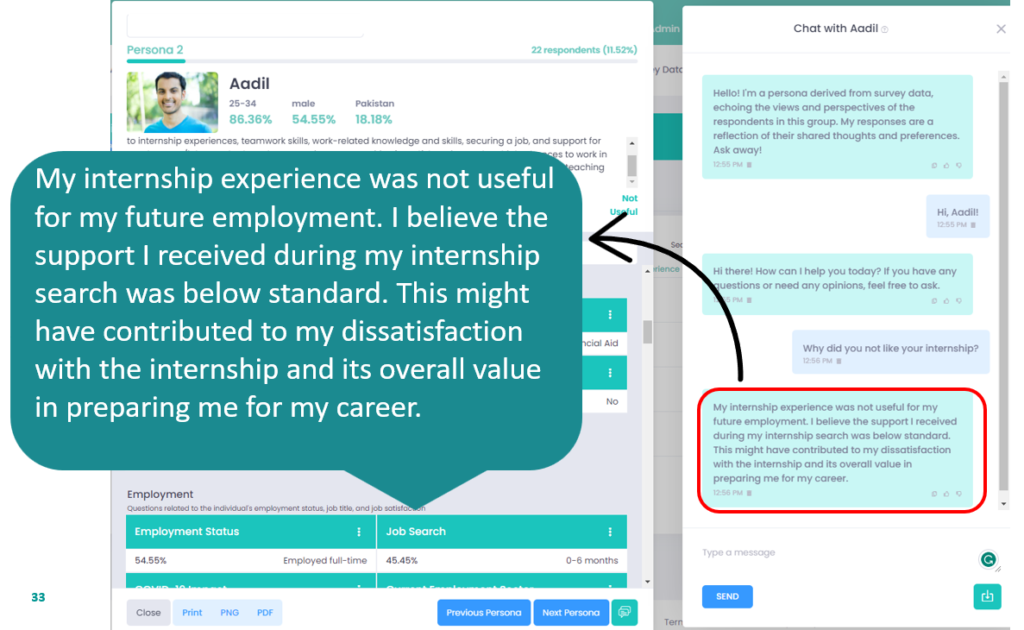In the realm of user experience (UX) design and marketing, personas have long been a cornerstone. Traditionally, these personas are static profiles – snapshots of the target audience created from data. However, with advancements in AI, particularly in generative models like GenAI, we can now transform these static profiles into truly interactive personas to revolutionize understanding and engagement with our target audience, customers, or users.
Historically, personas were created through market research, user interviews, and demographic studies. They provided a semi-fictional representation of our ideal customer or user, encapsulating their needs, goals, and behavior patterns. However, these traditional personas have limitations – they are fixed, unable to evolve or respond in real-time, and lack the depth required for nuanced understanding.
These shortcomings led to more data-driven personas and algorithmically created personas that leverage large amounts of data (big data) and machine learning (ML) algorithms.
However, approaches such as GenAI allow for ‘interactive personas.’
Interactive personas are AI-powered representations of audience, customer, or user profiles that enable real-time interaction and conversation for deeper understanding and engagement with the underlying data.
Interactive personas are about more than just simulating conversation. They’re designed to process, react, and respond like the target audience they represent. By interacting with interactive personas, UX designers, marketers, and product developers can gain deeper insights into the needs and motivations of their users and address more complex and nuanced questions, KPIs, and pain points. Leveraging the power of AI, particularly chatbot technology, these interactive personas go beyond static, flat file descriptions. Interactive personas are dynamic and can converse and respond to queries, making them more realistic and insightful.

One of the most significant advantages of interactive personas driven by AI is their ability to learn and evolve. As they interact with different end users, interactive personas can gather more data, refine their responses, and adapt their behavior. This continuous evolution ensures that they stay relevant and accurately reflect the changing dynamics of the target audience.
Interacting with a persona that can converse and express thoughts offers a unique opportunity to develop empathy. Interactive personas allow designers and marketers to step into the shoes of their users, perceive their challenges, and understand their aspirations on a deeper level. They will enable the end users to anthropomorphism the interactive persona.
Implementing interactive personas involves integrating GenAI with an existing audience, customer, or user data. This process requires careful planning, as the AI needs to be trained on diverse and comprehensive datasets to avoid biases and inaccuracies. Moreover, maintaining the balance between realistic simulation and ethical considerations is crucial.
As AI and ML technology, with HCI approaches, continue to advance, the potential for interactive personas is immense. We could see them become even more sophisticated, with capabilities like emotion recognition and predictive analytics. They could also be customized for different industries, offering specialized insights.
The transition from static to interactive personas marks a significant UX design and marketing milestone. These AI-powered interactive personas offer a more dynamic, empathetic, and accurate way to understand our users. As we continue to embrace these innovations, the possibilities for creating more user-centric products and services are endless. As such, interactive personas are more than just a technological advancement; they’re a gateway to deeper human connections using audience, customer, and user data for understanding real people in the digital world.
Read some research on interactive personas and audience, customer, and user understanding using data.
Jansen, B. J., Aldous, K, Salminen, J., Almerekhi, H. and Jung, S.G. (2023). Understanding Audiences, Customers, and Users via Analytics – An Introduction to the Employment of Web, Social, and Other Types of Digital People Data. Springer Nature.
Jansen, B. J., Jung, S.G., and Salminen, J. (2023) Employing Large Language Models in Survey Research. Natural Language Processing Journal. 4, 100020.
Kaate, I., Salminen, J., Santos, J., Olkkonen, R., Jung, S.G., and Jansen, B. J. (2023) The Realness of Fakes: Primary Evidence of the Effect of Deepfake Personas on User Perceptions in a Design Task. International Journal of Human Computer Studies. 178, Article 103096.
Jung, S.G., Salminen, J. and Jansen, B. J. (2022) Survey2Persona: Rendering Survey Responses as Personas. UMAP ’22 Adjunct: Adjunct Proceedings of the 30th ACM Conference on User Modeling, Adaptation and Personalization, 4-7 July, Barcelona (Spain), p. 67–73.

